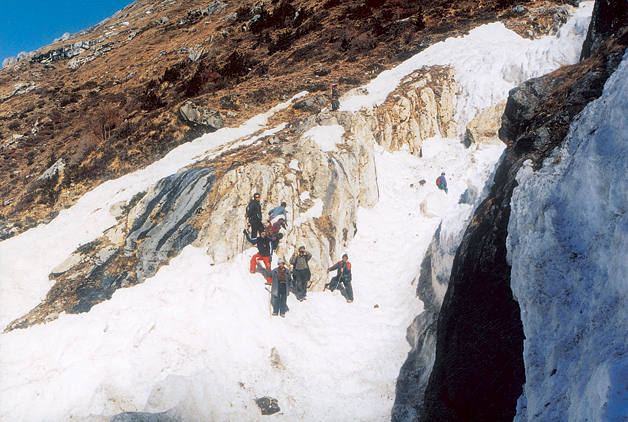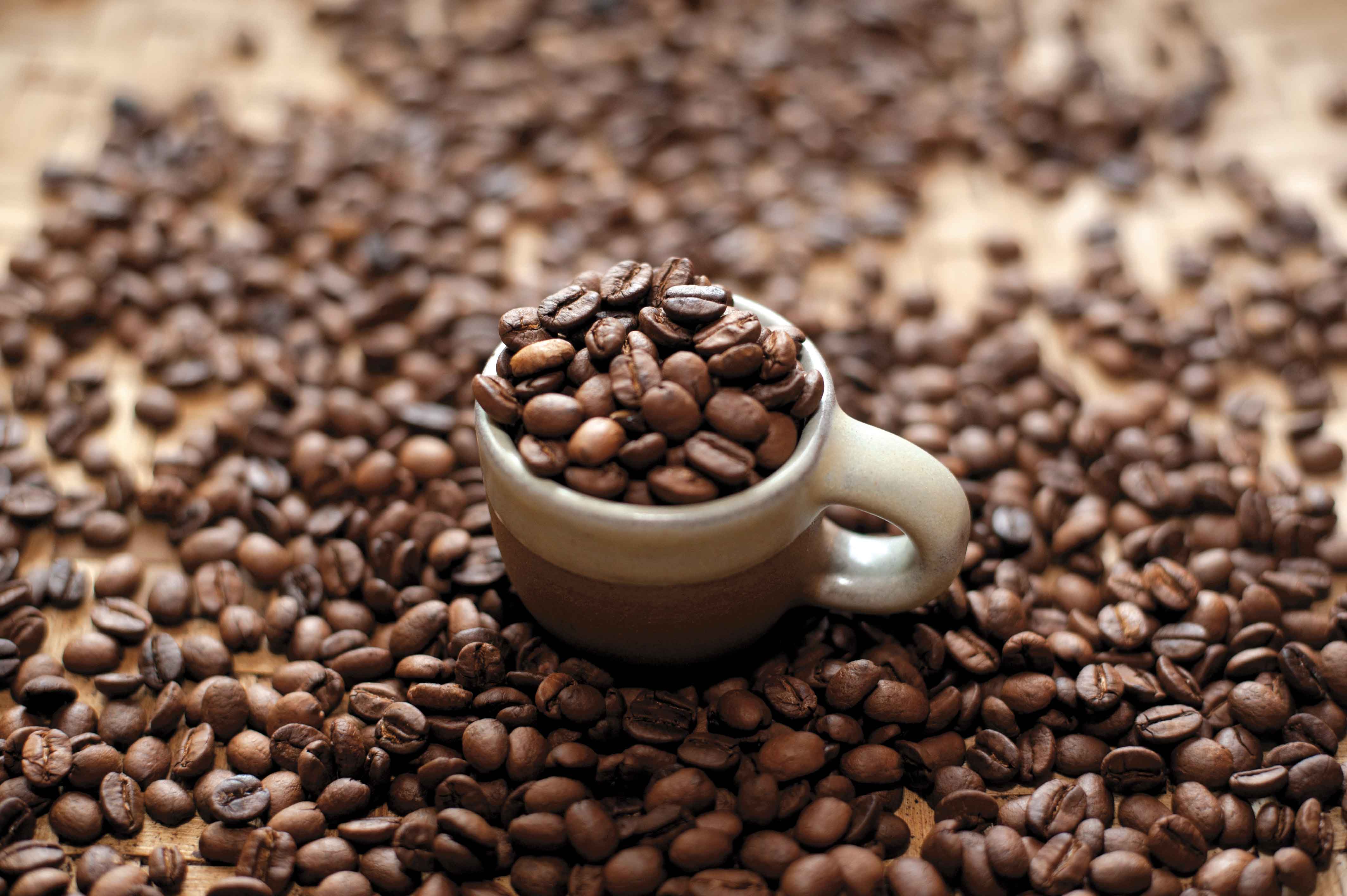
His heart wept as he bid fare well to his expecting wife and two daughters at Bholegaon in Rasuwa, to work as a team leader for porters. Aged 27, Dawa Lama in his endeavor to provide a better tomorrow for his family, was oblivious of what eventually would come to pass in the course of his journey to Mt. Kang Guru; an event that would change his perspective towards life, and those of many others.
After reaching the capital, Dawa went to the office of Churen Himal; the organizer of the 7 member French expedition team, and immediately became popular among the 38 porters who were hired to deliver necessary equipment and food for the climbers. Having acquainted himself with the French team, Dawa then prepared for the departure. Besides the porters, the expedition team also consisted of 15 Nepali members working as cooks, kitchen helpers and guides, under the command of Iman Singh Gurung, including Dawa. Eventually, a total of 60 eager individuals left Kathmandu on 3rd October 2005, and reached Bulbule via Beshisahar, a bus ride that takes about 9½ hours from Kathmandu.
The French and the Nepali support team separated after reaching Koto – the confluence of the Marsyangdi and Nar rivers, on the 4th day after departure and went westwards towards Upper and Lower Pisang, while Dawa and the porters made their trek towards Meta and eventually the Base Camp, which takes about 2 hours from Meta. Standing at 6981 meters, Mt. Kang Guru which lies between the Annapurna and Manaslu range – next to the Narphu valley, was indeed a picturesque sight but due to time constraints and the weather, Dawa could only marvel at its beauty in silence. Having fulfilled their part of the expedition, the porters returned, leaving Dawa and three others at the Base Camp on 9th October.
Due to his experience, the location of the Base Camp on a small hillock (4200m) towards the left of the peak was well chosen. The peak with a leeward slope towards the summit indeed looked harmless as 90% of avalanches start on slopes of 30 – 45 degrees. From there on, Dawa and his three friends tirelessly transported the merchandise to Camp I and Camp II. A day after the French and Nepali teams arrived on 12th October, rituals before the expedition were carried out and the entire team rested, having made plans to reach the summit on 22nd October.
The adverse weather on the fateful day was unexpected. An extreme snow blizzard engulfed Camp II and then Camp I. Not deeming appropriate and safe, Dawa with his friends returned to Base Camp around 3 pm. After melting water, preparing and consuming tea, Dawa felt the need to change his wet clothes before embarking on his next task. While in the process of changing around 4 pm inside the tent, Dawa and his three friends heard an explosion. Intuition told him that it must be an avalanche. In the next moment they found themselves floating on air amidst the snow (inside the tent), released by snow blowing from the windward sides of the ridges to the right, and were pushed approximately 100 m towards the left of the hillock into a crevasse. The French and the Nepalis did not as much realize what had occurred as they were washed southwards by the sheer power of gravity that exceeded the strength of the snow cover.
Without any shoes, gloves and proper clothing, Dawa came to his senses after what seemed like ages after the initial wave. Having found himself and only two of his friends alive, they desperately dug the snow with bare hands in search for the missing one. After finding him without any rescue gear, they braved their way towards the now bare Base Camp in search of survivors. With clothes torn off, they were now half naked. Much to their dismay, the entire camp was swept away and the need for survival at that extreme condition was urgent. Not knowing the whereabouts of the others, the treacherous return journey to Meta passed by in a blur though it took them more than 4 hours, and Dawa was in shock. They reached Meta around 8 pm in the evening and took shelter in a hotel, and there met two porters from a different trekking agency who offered them warm tea. Though the immensity of the incident had not sunk in, the only concern Dawa had at that moment was his determination to call the concerned people in the capital about the incident. While the two porters offered to go to Chame via Dharamshala to make the phone call, Dawa was offered warm clothing and a place to rest. He then broke down and cried among shocked onlookers and friends.
The porters on the way to Chame met another group coming up heading towards Meta. As they had a satellite phone, they made the necessary calls and reached Meta around midnight. The telephone lines at the French Embassy and the Himalayan Rescue Association (HRA) were abuzz on 21st October. HRA immediately coordinated a ‘Search and Rescue’ operation, but due to bad weather conditions and the unavailability of rescue helicopters in Kathmandu at that particular time, the rescue team could not immediately fly to point zero. Two days later, on 23rd October the first rescue team of 7, of the first rescue phase left on a MI 17 helicopter, under the leadership of Padam Ghale. They picked up the surviving 3 porters and transported them to Pokhara, where they received treatment. Dawa stayed back to assist the rescue operation.
The second rescue team left Kathmandu for Meta the next day along with Bikram Neupane – Chairman of HRA and coordinator of the rescue operations. As the weather and ground condition was not favorable, the team leader called from the Base Camp and informed them about the slim chances of finding survivors. Despite the adverse conditions, the rescue and search continued and Dawa tirelessly went on with the operation. On Tuesady, 25th October, a body of a French national was recovered and was identified as Bruno Chardin. His body was brought to Kathmandu the next day. All members of the first phase rescue team returned on 26th October, but Dawa with a Sherpa colleague stayed back. The same day, 4 French and 3 representatives of the Nepali support staff flew to Meta to assess the situation and returned the same day to reorganize the mission.
Having been the leader of porters, the presence of Dawa at Meta and the Base Camp was necessary. Being the only survivor present, he knew the location and was able to assist the rescue teams from HRA, including the ones conducted by Churen Himal. His selfless attitude towards the operation was not a sacrifice for the souls of the dead but for the living who were eager to know the whereabouts of their loved ones, even though the inevitable news was to be sad. Dawa also knew that news of the incident had reached his village and his wife, but he did not have any means of contacting them. Nevertheless, Dawa trudged on with the rescue effort, more determined now. The rescue and search team had returned because it was recognized that all 7 French and 11 Nepalis were buried in a gorge between 50 to 100 m deep, and that recovery was next to impossible. All that they could find were a jacket, two tents, a table and a chair. The only body recovered was that of a Nepali member of the expedition.
Detailed technical discussion for an effective operation was held in Kathmandu and on 31st October, the second phase rescue team flew to Meta, which comprised of 25 Nepalis, 5 French with two rescue dogs from France, and 7 kitchen support staff. They were transported by an Equerel and two MI 17 helicopters to search for the remaining 6 French climbers and 11 Nepali staff. This joint venture of the French Embassy and HRA was under the guidance and coordination of Padam Ghale. The incident site was also visited by the French Ambassador to Nepal – Michel Jolivet and Bikram Neupane on 3rd November, who supervised the ongoing search and rescue operation.
The entire rescue team worked to their limit in extreme conditions, using all available resources and techniques, but due to the heavy snow and the arrival of winter, they realized the hopelessness of finding any missing people. Thus, they decided to discontinue further search and returned to Kathmandu on 5th November, along with Dawa.
The return journey to his village took Dawa approximately 6 hours from Kathmandu. Though his wife had already heard of him being alive through his friends, Dawa was unaware of life’s better surprises. With passionate joy, his wife received Dawa, and his newborn third daughter was presented to him as a home coming gift. His spirit then elevated itself to the heights of Mt. Kang Guru and soared in the air of unmentionable bliss. At that moment, Dawa saw that life had a meaning and purpose in his daughters’ eyes.











